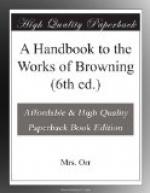This man describes the hustling and bustling, the crowding and packing—the suppressed stir as of human vermin imprisoned in a small space; the sham groans, and sham conversions which follow in their due course; and as he thus dwells on his national and personal degradation, his tone has the bitter irony of one who has both realized and accepted it. But the irony recoils on those who have inflicted the degradation—on the so-called Christians who would throttle the Jew’s creed while they “gut” his purse, and make him the instrument of their own sins; and is soon lost in the emotion of a pathetic and solemn prayer; the supposed death-bed utterance of Rabbi Ben Ezra.
The prayer is an invocation to the justice, and to the sympathy of Christ. It claims His help against the enemies who are also His own. It concedes, as possible, that He was in truth the Messiah, crucified by the nation of which He claimed a crown. But it points to His Christian followers as inflicting on Him a still deeper outrage: a belief which the lips profess, and which the life derides and discredits. It urges, in the Jew’s behalf, the ignorance, the fear, in which the deed was done; the bitter sufferings by which it has been expiated. It pleads his long endurance, as testimony to the fact, that he withstands Barabbas now, as he withstood Christ “then;” that he strives to wrest Christ’s name from the “Devil’s crew,” though the shadow of His face be upon him. The invocation concludes with an expression of joyful confidence in God and the future.
(Giacomo) “PACCHIAROTTO” was a painter of Siena.[91] His story is told in the “Commentary on the Life of Sodoma” by the editors of Vasari; Florence, 1855; and this contains all, or nearly all, the incidents of Mr. Browning’s “Pacchiarotto,” as well as others of a similar kind but of later occurrence, which are not mentioned in it.
This painter was a restless, aggressive personage, with a craze for reform; and a conspicuous member of the “Bardotti:” a society of uncommissioned reformers, whose occupation was to cry down abuses, and prescribe wholesale theoretical measures for removing them. (Hence their title; which signifies “spare” horses or “freed” ones: they walk by the side of the waggon while others drudge at, and drag it along). But he discovered that men would not be reformed; and bethought himself, after a time, of a new manner of testifying to the truth. He selected a room in his own house, whitewashed it (we conclude); and, working in “distemper” or fresco, painted it with men and women of every condition and kind. He then harangued these on their various shortcomings. They answered him, as he imagined, in a humble and apologetic manner; and he then proceeded to denounce their excuses, and strip the mask from their sophistries and hypocrisies—doing so with every appearance of success.




